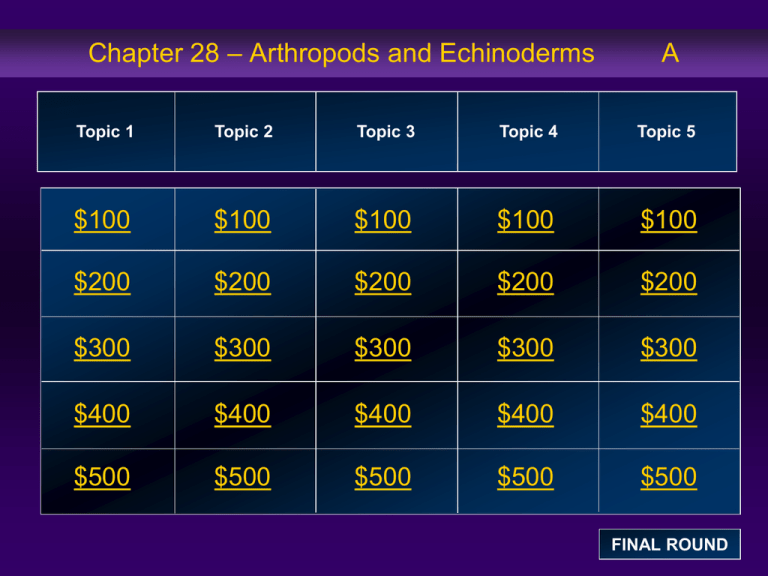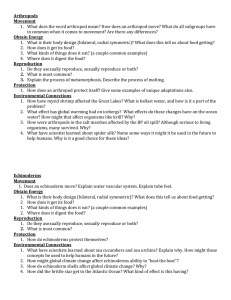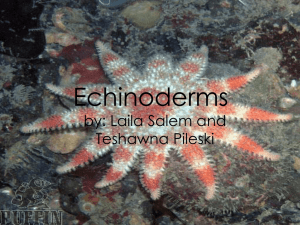Chapter 28 Jeopardy Review A
advertisement

Chapter 28 – Arthropods and Echinoderms A Topic 1 Topic 2 Topic 3 Topic 4 Topic 5 $100 $100 $100 $100 $100 $200 $200 $200 $200 $200 $300 $300 $300 $300 $300 $400 $400 $400 $400 $400 $500 $500 $500 $500 $500 FINAL ROUND Topic 1: $100 Question The structures labeled X in Figure 28-1 are filled with a. water. b. blood. c. air. d. nitrogenous wastes. ANSWER BACK TO GAME Topic 1: $100 Answer The structures labeled X in Figure 28-1 are filled with a. water. b. blood. c. air. d. nitrogenous wastes. BACK TO GAME Topic 1: $200 Question On the chelicerate in Figure 28-2, the appendage labeled 1 ia a(an) _____________. a. cheliped b. antenna c. eye d. pedipalp ANSWER BACK TO GAME Topic 1: $200 Answer On the chelicerate in Figure 28-2, the appendage labeled 1 ia a(an) _____________. a. cheliped b. antenna c. eye d. pedipalp BACK TO GAME Topic 1: $300 Question On the chelicerate in Figure 28-2, the appendages labeled 2, which contain fangs, are called ________. a. pedipalps b. legs c. chelicerae ANSWER d. trichomes BACK TO GAME Topic 1: $300 Answer On the chelicerate in Figure 28-2, the appendages labeled 2, which contain fangs, are called ________. a. pedipalps b. legs c. chelicerae d. trichomes BACK TO GAME Topic 1: $400 Question Insects have _______ pairs of legs. a. two b. three c. five d. six ANSWER BACK TO GAME Topic 1: $400 Answer Insects have _______ pairs of legs. a. two b. three c. five d. six BACK TO GAME Topic 1: $500 Question In echinoderms. Body parts usually occur in multiples of a. two. b. three. c. five. d. seven. ANSWER BACK TO GAME Topic 1: $500 Answer In echinoderms. Body parts usually occur in multiples of a. two. b. three. c. five. d. seven. BACK TO GAME Topic 2: $100 Question An example of an insect that undergoes incomplete metamorphosis is the a. moth. b. ladybug. c. chinch bug. d. bee. ANSWER BACK TO GAME Topic 2: $100 Answer An example of an insect that undergoes incomplete metamorphosis is the a. moth. b. ladybug. c. chinch bug. d. bee. BACK TO GAME Topic 2: $200 Question In most species of echinoderms, respiration occurs mainly in the a. tube feet. b. madreporite. c. radial canals. d. ring canal. ANSWER BACK TO GAME Topic 2: $200 Answer In most species of echinoderms, respiration occurs mainly in the a. tube feet. b. madreporite. c. radial canals. d. ring canal. BACK TO GAME Topic 2: $300 Question In the Great Barrier Reef of Australia, extensive areas of coral have been destroyed by the crown of thorns, which is a type of a. sea urchin. b. sea star. c. sea lily. d. sea cucumber. ANSWER BACK TO GAME Topic 2: $300 Answer In the Great Barrier Reef of Australia, extensive areas of coral have been destroyed by the crown of thorns, which is a type of a. sea urchin. b. sea star. c. sea lily. d. sea cucumber. BACK TO GAME Topic 2: $400 Question Sea lilies and feather stars a. Make up the oldest class of echinoderms. b. Feed by scraping algae from rocks. c. Are the only echinoderms that live in fresh water. d. Are disk-shaped echinoderms that often ANSWER burrow into the sand. BACK TO GAME Topic 2: $400 Answer Sea lilies and feather stars a. Make up the oldest class of echinoderms. b. Feed by scraping algae from rocks. c. Are the only echinoderms that live in fresh water. d. Are disk-shaped echinoderms that often burrow into the sand. BACK TO GAME Topic 2: $500 Question Which of the following statements about the water vascular system of echinoderms is correct? a. The tube feet are attached to the ring canal.. b. Each radial canal opens to the outside. c. The madreporite forms a circle around the animal’s mouth. d. The ring canal connects to the madreporite. ANSWER BACK TO GAME Topic 2: $500 Answer Which of the following statements about the water vascular system of echinoderms is correct? a. The tube feet are attached to the ring canal.. b. Each radial canal opens to the outside. c. The madreporite forms a circle around the animal’s mouth. d. The ring canal connects to the madreporite. BACK TO GAME Topic 3: $100 Question Two echinoderms that are in the same class are a. brittle stars and sea stars. b. sea stars and sea cucumbers. c. sea urchins and sand dollars. d. sea cucumbers and sea urchins. ANSWER BACK TO GAME Topic 3: $100 Answer Two echinoderms that are in the same class are a. brittle stars and sea stars. b. sea stars and sea cucumbers. c. sea urchins and sand dollars. d. sea cucumbers and sea urchins. BACK TO GAME Topic 3: $200 Question Which of these events is the first to happen when an arthropod molts? a. The animal fills with air or fluids. b. A new skeleton is secreted. c. The animal pulls itself out of the original skeleton. d. Skin glands digest the inner part of the skeleton. ANSWER BACK TO GAME Topic 3: $200 Answer Which of these events is the first to happen when an arthropod molts? a. The animal fills with air or fluids. b. A new skeleton is secreted. c. The animal pulls itself out of the original skeleton. d. Skin glands digest the inner part of the skeleton. BACK TO GAME Topic 3: $300 Question Which of the following is true of arthropods? a. They are all plant eaters. b. There are more species of arthropods than any other group of animals. c. They live only on land. d. Fossil arthropods appear recently compared to other animal groups. ANSWER BACK TO GAME Topic 3: $300 Answer Which of the following is true of arthropods? a. They are all plant eaters. b. There are more species of arthropods than any other group of animals c. They live only on land. d. Fossil arthropods appear recently compared to other animal groups. BACK TO GAME Topic 3: $400 Question Typical primitive arthropods had bodies that were composed of a. many segments. b. one segment. c. three segments. d. no segments. ANSWER BACK TO GAME Topic 3: $400 Answer Typical primitive arthropods had bodies that were composed of a. many segments. b. one segment. c. three segments. d. no segments. BACK TO GAME Topic 3: $500 Question The appendages of arthropods are a. found only on the head. b. hard and immovable. c. divided into six branches. d. jointed and extend from the body wall. ANSWER BACK TO GAME Topic 3: $500 Answer The appendages of arthropods are a. found only on the head. b. hard and immovable. c. divided into six branches. d. jointed and extend from the body wall. BACK TO GAME Topic 4: $100 Question What substance found in the skeleton of a desert-dwelling beetle is likely to be absent from the skeleton of an aquatic beetle? a. silk b. chitin c. wax d. protein ANSWER BACK TO GAME Topic 4: $100 Answer What substance found in the skeleton of a desert-dwelling beetle is likely to be absent from the skeleton of an aquatic beetle? a. silk b. chitin c. wax d. protein BACK TO GAME Topic 4: $200 Question Which of the following invertebrates is NOT a crustacean? a. fiddler crab b. barnacle c. crayfish d. horseshoe crab ANSWER BACK TO GAME Topic 4: $200 Answer Which of the following invertebrates is NOT a crustacean? a. fiddler crab b. barnacle c. crayfish d. horseshoe crab BACK TO GAME Topic 4: $300 Question If a butterfly touches sugar water with one of its legs, it usually will begin to feed. If it touches salt water, it usually will not feed. The most likely explanation for this difference in response is that butterflies a. Use the ears behind their legs to distinguish sugar water from salt water. b. Can distinguish sugar water from salt water by sight. c. Have chemical receptors for taste on their legs. d. Cannot tell the difference between sugar water ANSWER and salt water. BACK TO GAME Topic 4: $300 Answer If a butterfly touches sugar water with one of its legs, it usually will begin to feed. If it touches salt water, it usually will not feed. The most likely explanation for this difference in response is that butterflies a. Use the ears behind their legs to distinguish sugar water from salt water. b. Can distinguish sugar water from salt water by sight. c. Have chemical receptors for taste on their legs. d. Cannot tell the difference between sugar water and salt water. BACK TO GAME Topic 4: $400 Question The respiratory organ in terrestrial chelicerates is the a. chelicera. b. book gill. c. book lung. d. pedipalp. ANSWER BACK TO GAME Topic 4: $400 Answer The respiratory organ in terrestrial chelicerates is the a. chelicera. b. book gill. c. book lung. d. pedipalp. BACK TO GAME Topic 4: $500 Question One difference between a nymph and a larva is that a nymph a. molts to become a pupa, but a larva molts to become an adult. b. is specialized for reproduction, but a larva is not. c. can fly, but a larva cannot. d. resembles an adult of the same species, but a larva does not. ANSWER BACK TO GAME Topic 4: $500 Answer One difference between a nymph and a larva is that a nymph a. molts to become a pupa, but a larva molts to become an adult. b. is specialized for reproduction, but a larva is not. c. can fly, but a larva cannot. d. resembles an adult of the same species, but a larva does not. BACK TO GAME Topic 5: $100 Question When a honeybee performs the waggle dance, the direction of the food is indicated by the a. number of straight runs in the dance. b. frequency with which the bee changes direction. c. direction of the straight run. d. number of circles in the dance. ANSWER BACK TO GAME Topic 5: $100 Answer When a honeybee performs the waggle dance, the direction of the food is indicated by the a. number of straight runs in the dance. b. frequency with which the bee changes direction. c. direction of the straight run. d. number of circles in the dance. BACK TO GAME Topic 5: $200 Question Honeybees use dances to a. lure insects of other species. b. attract mates. c. signal the death of a member of the colony. d. convey information about food sources. ANSWER BACK TO GAME Topic 5: $200 Answer Honeybees use dances to a. lure insects of other species. b. attract mates. c. signal the death of a member of the colony. d. convey information about food sources. BACK TO GAME Topic 5: $300 Question Echinoderms are like vertebrates in that echinoderms a. are brilliantly symmetrical as larvae and as adults. b. have cephalization. c. are deuterostomes. d. have an anterior end and a posterior end. ANSWER BACK TO GAME Topic 5: $300 Answer Echinoderms are like vertebrates in that echinoderms a. are brilliantly symmetrical as larvae and as adults. b. have cephalization. c. are deuterostomes. d. have an anterior end and a posterior end. BACK TO GAME Topic 5: $400 Question Which structure is part of an echinoderm’s water vascular system? a. skin gill b. stomach c. anus d. madreporite ANSWER BACK TO GAME Topic 5: $400 Answer Which structure is part of an echinoderm’s water vascular system? a. skin gill b. stomach c. anus d. madreporite BACK TO GAME Topic 5: $500 Question In arthropods, the main nerve cord runs along the __________ surface of the body. a. dorsal b. proximal c. anterior d. ventral ANSWER BACK TO GAME Topic 5: $500 Answer In arthropods, the main nerve cord runs along the __________ surface of the body. a. dorsal b. proximal c. anterior d. ventral BACK TO GAME FINAL ROUND Question Question: a. Choice 1 b. Choice 2 c. Choice 3 d. Choice 4 ANSWER BACK TO GAME FINAL ROUND Answer Question: a. Choice 1 b. Choice 2 c. Choice 3 (correct answer) d. Choice 4 BACK TO GAME









